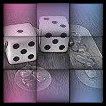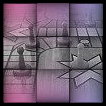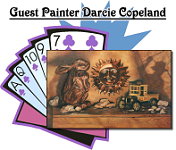
Click here for site NEWS.

Click here to read about the summer's Featured Artists!

Visit the site's Guest page.
* * *
* CLICK HERE *
to learn more about Pachisi, or continue scrolling
down the page.
|
|
2011 WEBSITE SPECIAL GUESTS
Each summer special guests are invited to exhibit works on the site which
either express or in some way interpret the summer theme. The 2011 theme was "Game Changer," and the site welcomed a Guest Photographer, Guest Painter, Guest Poet, and
Guest Printmaker. Information about them was included below.

 


GUEST PHOTOGRAPHER

His photographs can be found on the "All Cities By City" concert page.
Click here to visit that page now.
GUEST PAINTER DARCIE COPELAND

Artist's Statement: "My personality lends itself to the humorous side of life, which allows me to express myself through my work, while I continually strive to
stretch the boundaries of my viewer’s imagination. My method of expression is through the Rebus (ree-bus), a puzzle or riddle in which pictures represent words or phrases. I invite you to play the game of
solving each Rebus by the obvious and hidden clues within each of the paintings." The paintings can be found on the "All Cities By Date" concert page.
Click here to visit that page now.
Painter Darcie Copeland of Orange is a member of the International Guild of Realism,
Oil Painters of America and Women Artists of the West, and she is a long-time exhibitor at the Laguna Beach Art-A-Fair. Her paintings are done primarily in oil on linen, and later this summer her work also will be on exhibit in a solo
show at Copperwood Artware in Orange during July and August. To find out more about Darcie's Rebus paintings
and her Rebus game, visit her website at www.darcieart.com.
GUEST POET

The works of the Guest Poet can be found by following the links to the "Guest Poet" page.
Click here to visit that page now.
GUEST PRINTMAKER

Images of his works are included on the Guest Poet pages accompanying the
poems. Click here to visit the Guest Poet page now.

|
"The essence of strategic skill lies always in choosing the right move. The reason why Snakes and
Ladders is a game of pure chance, despite starting from a known and equal position, is that the player in turn has no choice but to roll the dice and move as directed. But choice alone is not
enough: it must be significant choice. Ludo is a game of chance, despite the choice of moves, for the very reason that there is no point in having a choice if players have no way of
telling whether one move is likely to be better than another . . . The defining feature of a game of skill is not the absence of chance but the presence of significant choice."
David Parlett "What's in a Game?" chapter
from the Oxford Guide to Card Games
The Game of Pachisi
 Pachisi, meaning twenty five, is often described as the national game of India. It is closely related to the
game of Chaupur, which reached its heyday in the 16th century Mogul dynasty. It is said that "large boards [of human scale] marked out with inlaid marble [were found] on the palace courtyards at Agra and
Allahabad . . . The Emperor Akbar played the game on this scale, directing from a central dais the movements of sixteen slave-girls from the harem dressed in the traditional four colors of the
various pieces." (Parlett) Another author notes that "While the rules [of the game] have not changed since the emperor's day, the equipment surely has." (Scarne) Pachisi, meaning twenty five, is often described as the national game of India. It is closely related to the
game of Chaupur, which reached its heyday in the 16th century Mogul dynasty. It is said that "large boards [of human scale] marked out with inlaid marble [were found] on the palace courtyards at Agra and
Allahabad . . . The Emperor Akbar played the game on this scale, directing from a central dais the movements of sixteen slave-girls from the harem dressed in the traditional four colors of the
various pieces." (Parlett) Another author notes that "While the rules [of the game] have not changed since the emperor's day, the equipment surely has." (Scarne)
American players are likely to be most familiar with the American version of the game, Parcheesi, and British with their
version, Ludo, which was introduced to the country in the late 1800s. Both are more simplified children's/family versions of the game "played all-against-all, where Pachisi itself is a relatively skill-demanding partnership game, rather
like a four-handed Backgammon." (Parlett)
Pachisi is typically a four-player game played on a cruciform-shaped board in which each player has four game
pieces and players sitting opposite each other are partners. Players move out from a central location and around all arms of the board, returning up to the center by exact count. Cowrie shells were originally thrown to dictate the
number of spaces a player moved; today dice are used.
Also from India is a game called Snakes and Ladders (moksha-patamu, not pictured), a game likely to have been the
inspiration for the U.S. children's board game Chutes and Ladders. The game originally was "designed as a tool to instruct children in moral virtues . . . On the moksha-patamu board, good deeds enabled the soul to climb ladders to
higher levels of enlightenment, avoiding many passes across the board. Wicked deeds caused the soul to slide . . . downward on the backs of serpents, necessitating retracing steps already taken." . . . Passage [across the 10 x 10 square grid board] was
determined by the throw of cowrie shells, and "vivid paintings often represented both the virtues and vices and heights or depths to which they might bring the soul." (Wilkins).
Reference Sources:
Bell, R.C. Board and Table Games from Many Civilizations. New York: Dover Publications Inc., 1979.
Parlett, David. The Oxford Guide to Card Games, Oxford/New York: Oxford University Press, 1990.
Parlett, David. The Oxford History of Board Games, Oxford/New York: Oxford University Press, 1999.
Scarne, John. Scarne's Encyclopedia of Games, New York: Harper and Row Publishers, 1973.
Wilkins, Sally. Sports and Games of Medieval Cultures, Westport, Connecticut: Greenwood Press, 2002.
|


Follow www.dorothyswebsite.org on TWITTER!
Home | Essays |
Poetry | Free Concerts | Links | 2011 Extras |
About the Site
Featured Artists | 2011 Website Special Guests | News
|
|
|












 Pachisi, meaning twenty five, is often described as the national game of India. It is closely related to the
game of Chaupur, which reached its heyday in the 16th century Mogul dynasty. It is said that "large boards [of human scale] marked out with inlaid marble [were found] on the palace courtyards at Agra and
Allahabad . . . The Emperor Akbar played the game on this scale, directing from a central dais the movements of sixteen slave-girls from the harem dressed in the traditional four colors of the
various pieces." (Parlett) Another author notes that "While the rules [of the game] have not changed since the emperor's day, the equipment surely has." (Scarne)
Pachisi, meaning twenty five, is often described as the national game of India. It is closely related to the
game of Chaupur, which reached its heyday in the 16th century Mogul dynasty. It is said that "large boards [of human scale] marked out with inlaid marble [were found] on the palace courtyards at Agra and
Allahabad . . . The Emperor Akbar played the game on this scale, directing from a central dais the movements of sixteen slave-girls from the harem dressed in the traditional four colors of the
various pieces." (Parlett) Another author notes that "While the rules [of the game] have not changed since the emperor's day, the equipment surely has." (Scarne)